Impact of Brexit on the UK's Construction Industry
Info: 9316 words (37 pages) Dissertation
Published: 9th Dec 2019
Tagged: ConstructionBrexit
Evaluating the Impact and Implication of BREXIT in the UK Construction Industry
Abstract
Brexit is an abbreviation of ‘British exit’ and was introduced in 2016 following Britain’s decision to hold a referendum regarding the status of Britain in the European Union. On the morning of the 24th of June 2016, it was announced that Britain would be exiting the European Union. This decision has left uncertainty concerning the future of the UK construction industry due to the current heavy reliance on foreign labour – especially European skilled labourers.
The purpose of this paper is to present an understanding of the potential impact of Brexit on the UK construction industry. The research examines the construction industry’s reliance upon the European Union for skilled labour and determines the possible effects Brexit poses on the free movement of skilled labourers within the industry.
The author undertook a literature review that critically evaluated and summarized all relevant information currently available in relation to Brexit and its effect on the UK construction industry. This was carried out via a desk study using journals, newspapers, books etc. The evidence collated from this gave the author a deeper understanding of the attitudes of various construction professionals on the issue of Brexit.
A perceptual questionnaire was used to obtain responses from construction professionals using chain sampling. Summary statistical analysis of Likert item scale data was then used to explicate upon respondents’ views and provide an analysis of the data in comparison to that obtained in the literature review.
The research concluded that the majority of survey participants either ‘agreed’ or ‘strongly agreed’ that the UK construction industry is heavily reliant upon EU skilled labour and that the industry will be an unattractive option for skilled labour post-Brexit. The paper provides recommendations that will lower the risk of Brexit further aggravating the existing skills shortage the construction industry is currently facing.
1. Introduction
1.1 Background
The construction industry is one of the most influential industries within the UK economy, contributing a total of £102 billion (Rhodes, 2015). The sector employs roughly 2.11 million people each year, which is equivalent to 6.2% of UK employment (Rhodes, 2015). Unlike other sectors, construction is heavily reliant upon skilled, semi-skilled and unskilled workers (Smith, 2016), with 8% of the sector’s workforce coming from the EU (Fletcher, 2017). However, the growth of construction is being held back due to the on-going skills shortage the UK is facing, as well as the uncertainty of Brexit (RICS, 2017).
On the 23rd of June 2016, a referendum was held in the United Kingdom, which saw the British people voting for whether they wanted to leave or remain within the EU (The Electoral Commission, 2016). There was a 71.8% turnout with 51.9% of participants voting to leave, and 48.1% voting to remain within the EU (Hunt and Wheeler, 2018). With this decision to leave the EU comes a number of consequences for the UK in general and more specifically the construction sector. The main repercussion of Brexit is the likelihood of seeing an end to the free movement of people within the EU; this could potentially see 194,000 workers denied access to the UK (Colvile, 2017), with restrictions to access of the single market and free trade being enforced (European Movement International, 2016). The restriction of foreign workers movements into the UK will only serve to increase the severity of the skills shortage and therefore the rate of construction output will decrease whilst the cost of projects will increase (Onions, 2016).
1.2 Aims and Objectives
This paper aims to analyse the potential impact of Brexit on the construction industry and the labour workforce, whilst providing recommendations that will minimize the risks that the UK construction sector potentially faces as a result of BREXIT. Following are the key objectives identified:
1. To evaluate the current situation of the skilled and unskilled labour in the UK construction industry labour market.
2. To analyse the present reliance of UK construction industry on the foreign skilled and unskilled workers especially from the EU countries.
- To understand BREXIT and its possible effects with a particular focus on the UK construction industry.
- To evaluate the impact of BREXIT on the free movement of the construction labour to the UK.
2. Literature Review
2.1 UK Labour Construction Market
The construction industry is one of the major contributors to the UK economy (Fien and Winfree, 2014). It generates approximately £90 billion each year, which equates to 6.7% of the UK’s GDP (Rhodes, 2015). According to The Department for Business Innovation and Skills, the construction industry employs 2.93 million people, which is the equivalent of 10% of UK employment (DFBIS, 2013). In order to maintain this level of employment, the industry relies upon skilled labour to carry out infrastructure projects (Rolfe and Hudson-Sharpe, 2016). A report published states that the economic growth of the UK is being restricted by a significant skills shortage (The Hays Global Skills Index, 2012). This will affect the clients’ requirements in terms of cost, time and quality, as the construction sector is heavily reliant upon its workforce. However, the ageing workforce combined with the lacking inflow of new workers will in time lead to an even larger skills crisis.
Currently, 22% of the construction workforce is over 50. This highlights the numbers set to leave the industry due to retirement, bringing the overall amount of people leaving the construction industry to over 1800 a year (KLH Sustainability, 2016). The Construction Industry Training Board (CITB) carried out studies and forecasted that 400,000 employees will retire within the next ten years, with 182,000 new workplaces available in the next five years (CITB, 2016). This further highlights the skills shortage due to an ageing workforce that the UK is currently experiencing.
At present, there are not enough people with the required skills to meet the needs and expectations of UK employers (Mike Boxall, 2016). The Organisation of Economic Cooperation and Development (OCED) published a report that found teenagers in England had one of the lowest levels of literacy and numeracy out of the 23 countries surveyed (OCED, 2016). Without young people having the right skills, training and knowledge, the construction industry will face an on-going shortage of skills, which will have a knock-on effect on the wider economy (Neil Martin, 2016). It is crucial to ensure that young people are taught the relevant skills needed for the industry and then maintain and further improve these during their working life in the labour market (Davos-Klosters, 2014).
Several studies and reports have however found that young people do not find the construction industry an attractive career path for their future (Allister Hayman, 2014). The appeal of the construction industry as a career choice for young people is as low as “4.2 out of 10 among 14 to 19-year-olds” (CITB, 2013). This is backed up by a study conducted in the same year with results showing a 14.6% fall in the number of apprenticeships in the construction industry (UCATT, 2013). This suggests that despite the diverse and varied job roles the construction industry has to offer, it simply does not prove an attractive option for young people. This may be down to a general misconception of the industry that exists amongst the population due to the industry being dominated by males, low pay and a lack of job security (Construction 2025, 2013). This is consistent with a study carried out in 2015 with findings that the lack of technology and poor health and safety records are off-putting in an industry already seen as dirty and strenuous (Construction 2030 and Beyond, 2015).
The need to take action to combat these issues has been recognised by the industry. It is a widely held view that there should be a stronger focus on promotion of construction towards a wide range of people and portraying it in a light that will make it appealing to join (Construction 2030 and Beyond, 2015). This can be achieved by introducing 3D Modelling and Building Information Modelling in the education system to attract the younger generation to the construction career path. This use of technology will also reduce the skill requirements needed, opening up careers to a wider set of people.
2.2 Foreign Workers in Construction
The construction industry is an industry that is greatly affected by fluctuations in the UK economy. Due to its volatility, when hit by an economic crisis, it is common for firms to delay construction projects. This leads to a significant decline in construction output (Tejvan Pettinger, 2010). The 2008 recession notably decreased construction output, with a PMI value of 47.1 – values less than 50 indicate contraction (The Chartered Institute of Purchasing and Supply and Markit, 2010). This demonstrates how vulnerable the construction sector is to economic changes.
With the sector making an on-going recovery from the 2008 recession, the skills shortage is set to worsen in the coming years (One Way, 2016) forcing contractors to recruit a higher number of migrant workers in order to meet the skills demand. Figures show that a total of 33% of construction workers are from EU countries (ONS, 2016). Freedom of movement has been a cornerstone of industry success, and something that the industry relies heavily upon (Guglielmo Meardi, 2017). The imminent threat of a lack of freedom of movement, combined with the existing skills shortage has potential to negatively impact the UK’s construction industry performance (McLeod and Milne, 2016). Due to the construction industry having volatile economic conditions that correspond with fluctuating labour demands, the current skills crisis is likely to be further aggravated due to the restriction on overseas skilled labour, given the heavy reliance on Eastern Europe (Green, 2015; Rolfe and Hudson-Sharp, 2016). This is reaffirmed by Green (2016) who suggested that the UK’s departure from the EU could cause a severe labour shortage. The Royal Institute of Chartered Surveyors confirmed that the UK construction industry could face losing 200,000 EU workers if the country fails to retain access to the single market (RICS, 2017) Both these findings demonstrate the importance and extent of how migrant EU workers contribute a significant amount to construction. The capital city is one of the most affected cities with 27% of the construction workforce being from the EU (Housing in London Report, 2017).
2.3 Reasons for Brexit
The main driving force behind the UK’s decision to leave the EU has been down to a high level of hostility towards immigration and its potentially damaging impact on the economy due to ‘benefit tourism’; it can also be attributed to the desire to retain national control given widespread views of a ‘lack of control’ (Tilford, 2016; Minford and Lyons, 2016; Springford, 2013). Other reasons include a perceived preference for EU migrant workers over British workers due to cheaper labour costs (Ruhs and Anderson, 2012). There is a general public concern that the government is unable to manage migration competently (TUC, 2016) which has caused the public to have a cynical view towards the EU due to a lack of control surrounding immigration (Tilford, 2016). This public perception has differed to the opinions of employers who believe EU workers have a ‘superior work ethic’ compared to that of UK workers (Rolfe and Hudson-Sharpe, 2016). The UK construction industry, in general, acknowledges the necessity for free movement between the UK and EU in order to have an industry that is thriving (Lewis, 2017). A study conducted by CITB (2017) found that employers are highly dependent on migrant workers.
Despite the ambiguity of the economy and construction sector post Brexit, it is noticed that there’s been a 28% increase in office construction within London (Deloitte, 2016). This indicates that any impact Brexit may have on the industry may be based upon individual sectors or regions in the UK. Contrary to this, it is thought that a “leave vote” will impact the availability of labour once article 50 is triggered due to free movement likely being restricted during this time (Wasniowski, 2016).
This is already having an impact as the economic uncertainty has caused some projects to be put on hold (Partington, 2017). Given the current political situation, it is unlikely that the current arrangement of free movement of labour between the UK and EU will still exist post-Brexit (Rolfe and Hudson-Sharp, 2016). The additional skills shortage that will likely prevail post-Brexit will exacerbate labour requirements (Xinhua, 2017).
2.4 Effects of Brexit
At present, it is uncertain whether the UK will undergo a ‘hard’ or ‘soft’ Brexit. Theresa May (UK’s prime minister), who represents the ‘leave’ constituency, made a speech affirming that ‘Brexit means Brexit’ and there will be no attempts made to stay within the EU (Cowburn, 2016). Despite this, it is unclear as to the position the construction industry will be in with regards to having access to the free movement of EU workers (Onions, 2016). Any restrictions imposed will prove to be highly challenging for a sector that is already suffering a skills crisis (Onions, 2016), and will make EU workers consider other countries that have a lower restriction on migrant labour (Wilson, 2016). However, regaining control of immigration was the driving force of the Leave Campaign making it likely that some form of restriction will be imposed on migrant workers and immigration whilst also impact the type of Brexit the UK adopts (Swales and Baker, 2016). Conversely, there is widespread belief that exiting the EU will bring significant benefits to the industry. (Ellis, 2016) suggested several effects of BREXIT that could prove beneficial for the industry in the long run. The first of these is the reduction of red tape, which could facilitate greater trade countries outside of the EU. (Ellis, 2016) also suggests the ease of free movement of goods and forming new trade deals without being “hampered by the cost of EU membership” and being able to have a broader access to talents that are beyond the EU.
CHAPTER 3 RESEARCH METHODOLOGY
Introduction
This chapter aims to discuss and justify the research methodology and data collection approach that was adopted by the author when undertaking the research. There are two main approaches to data collection; namely quantitative and qualitative research (Naoum, 2007). Howe (1999) suggests that the use of both approaches can strengthen the findings.
Research Approaches
Mixed Methodology
This research utilises mixed methodology, as it is a better methodology that uses both qualitative and quantitative methodology rather than employing only one technique in a single study (Creswell and Clark, 2007).
Quantitative Research
Quantitative analysis is an objective methodology of research that is normally used when a problem can be quantified by collecting data in a numerical form that can then be generated into usable statistics (Saunders et al., 2009). This type of research is objective in nature, and is designed to give numerical results, which can be reported in the form of charts and graphs (Naoum, 2007). Creswell and Clark (2007) have defined quantitative analysis as the testing of a theory or hypothesis that is analysed statistically and if necessary amendable. This research will use surveys and secondary data sources as a form of quantitative data collection. Non-probabilistic sampling will be used where the researcher will rely on the chains of referrals after requesting few personal contacts to refer the survey to their colleagues and social- circle working in the local construction industry. The author adopted this strategy by designing a survey form that was distributed to construction professionals working in the UK construction industry.
Qualitative research
Contrarily, qualitative research is subjective in nature. The results of qualitative research are more descriptive than predictive (QRCA, 2017). It collects empirical data, values, meanings and experiences with the intention of gaining an understanding of underlying opinions (Naoum, 2007). The qualitative approach begins by collecting the facts and realities that are used to develop the theory rather than relying on the existing theories. This strategy is useful when opinions providing insights of relevant participants are important. Information collated under qualitative research can be in the form of individual interviews or structured/semi-structured interviews and is classified under two categories of research; exploratory research and attitudinal research.
Exploratory or attitudinal research
Exploratory research intends to explore research questions and helps to achieve a better understanding without the intention of offering a conclusive solution to a problem (Singh, 2007). This research type is often conducted to research a problem that lacks a clear definition. Unstructured interviews are the most common method of primary data collection for exploratory studies. On the other hand, attitudinal research involves the researcher subjectively evaluating the opinion and perception of a person towards a specific question (Naoum, 2007).
Approaches to data collection
When conducting a research paper, the data collection approach will vary depending on the nature of the investigation and information required.
Desk study research – Secondary Data collection
Secondary research – also known as a desk study – involves collecting information from existing data such as government department reports, internet searches and library reports. This paper uses secondary data to aid in conducting the literature review. In regards to construction research, secondary data is either stored in a statistical format such as official statistics collected by institutions such as RICS, CITB and CIOB, or in a descriptive format in which documents are stored as books, journals and newspaper articles. Both statistical and descriptive data has been used to allow realistic and accurate assumptions to be made regarding the current situation of the construction sector in the aftermath of Brexit.
Fieldwork research – Primary data collection
Primary research is a technique used to gather factual, first-hand information, specific to a particular subject (Kowalczyk, 2015). There are several ways to conduct primary research such as surveys (offline and online), interviews (structured and unstructured), observation and focus groups. However, the use of the most appropriate type of technique depends on the research topic, researcher’s expertise, time and resources allowed to conduct the research. The author adopted this strategy by using a questionnaire to gather information from respondents regarding the effects of Brexit on the UK construction industry.
Justification
The author chose to use quantitative research strategies alongside the use of the desk study and fieldwork data collection approaches due to the lack of resources available, cost and time constraints, and the ease of obtaining and using data with these techniques. Whilst a qualitative approach would have offered more insight and depth into the research through the use of individual interviews, the time constriction and inadequate resources made this approach futile. However, qualitative research is only able to cover a small sample and simply develops ideas for further research. Quantitative research on the other hand has a more structured technique that can cover a larger sample and quantify defined variables such as attitudes and opinions for the research. The author adopted the desk study approach due to the wide availability of data and the speed and cheap cost required to obtain the information despite the lack of aptness it may have.
Questionnaire
Questionnaire surveys are one of the most widely used data collection methods for conducting descriptive surveys (Naoum, 2007) and shall be used for the primary data collection in this investigation. This approach is the least expensive method of collecting a large amount of data and has the highest response rate compared to other survey methods (Nolinske, 2017). Other advantages of questionnaires include the ease of data analysis, a lower risk of bias, and the familiarity of a survey for participants (Walonick, 2014). However, questionnaires are unable to provide the opportunity to probe ambiguous responses (Naoum, 2007). This can be overcome by providing participants a comments section should they wish to expand upon their responses.
Questionnaire designing
Naoum (2007) suggests constructing the questionnaire in three stages. The first should consider the aims and objectives of the paper to produce a list of possible questions relevant to the research (Naoum, 2007). Secondly, organise the list of questions relating to the objectives in a logical order. Lastly, the wording of all questions should be checked (Naoum, 2007). The author adhered to this construction format and was able to develop a questionnaire in which each question was linked to a specific objective of the research.
Types of questions
Open Ended vs Closed Ended
There are two main classifications of questions: open ended and closed ended. Open questions allow participants to freely express their views, though this can make results harder to interpret and analyse due to the general range of responses received. Closed questions on the other hand are quick to answer and require little or no writing from the participant and are often presented in a ‘tick-box’ format, yes/no, or numerical scoring (Naoum, 2007). This small range of options can however introduce bias due to the provision of answers that may not have previously been considered.
The use of closed ended questions will be adopted in this investigation so as to reduce the time taken for respondents to complete the survey. Due to the sample consisting of construction professionals, they are unlikely to have a lot of spare time and using open-ended questions would increase the prospect of receiving a low response rate.
Factual Questions
The questionnaire begins with a series of factual questions, which provides an opportunity for the author to gain an understanding of the participants’ backgrounds and confirm their eligibility to provide competent, meaningful responses. This is followed by a series of closed-ended questions. The remaining questions are subjective ones which elicit the opinions of participants and are asked in a Likert scale format.
Likert Scale
The Likert scales are a form of questions consisting of attitudinal statements relating to the subject of the survey, ranging from one extreme of favourableness to the other (Naoum, 2007). It gives the participants the chance to answer questions based on a points scale depending on their level of agreement with the given question or statement.
Wording of Questions
Naoum’s (2007) third stage of designing a questionnaire is to ensure the wording of questions are checked in a way that will make it easier for the author to analyse, and quick and simple for the participants to answer (Brace, 2004). Issues such as ambiguity, bias, inadequate response options and misunderstanding are all factors that should be considered and avoided when designing a questionnaire.
Structure of Questionnaire
The questionnaire should be organised in such a way that will minimise confusion and bias (Rea and Parker, 2005). The author has begun the survey with simple introductory questions and grouped relevant questions together, which will allow participants to focus on specific related topics. The questionnaire has been designed in a way that covers the scope of the study, whilst maintaining a concise format to encourage participants to complete the questionnaire.
Random Sampling
Random sampling is the technique in which each sample has an equal opportunity of being chosen. The author has chosen to adopt this method in order to gain an unbiased sample and distributed the questionnaire to various offices where construction professionals were working. This allowed the author to identify the population from which the sample was to be drawn.
Data Analysis
The quantitative data collated were analysed using summary statistical analysis in order to provide a pragmatic and simple description of the data. Excel was extensively used to perform the statistical techniques on the numerical data gathered from the survey. The results were then presented in the form of tables and graphs.
Ethical Considerations
The author completed the Coventry University Ethical Approval process as a mandatory process before commencing the project. This was approved and was carried out in compliance with the university’s Code of Research Ethics. A participant information sheet and consent form was given out along with the questionnaire to ensure the participants understood the purpose and nature of the research. Aspects such as confidentiality of data were included in this.
Summary
This chapter has successfully discussed and justified the research methodologies undertaken in this project. A closed-ended questionnaire in the form of a Likert Scale was designed and distributed to a random sample of construction professionals. Questions were concise, logically ordered, and clearly presented to ensure a high response rate.
Chapter 4
Introduction
This chapter aims to provide an analysis of the results obtained from the questionnaire survey data collected. This analysis will enable the author to critically discuss observations and make an own interpretation of the results.
Competency Questions
At the start of the questionnaire, participants were asked to complete three competency questions to validate their eligibility in taking part. The participants first had to confirm they were construction professionals. All 20 participants confirmed they were construction professionals and therefore eligible to partake in the questionnaire. They were then asked to give their age range and number of years experience in construction. Both questions were aimed at establishing the quality of the survey results. The results revealed that the majority of participants were between the ages of 25-35 years, with the rest being between 36 and 54 years of age (INSERT FIGURE NUMBER). This demonstrates the mature age range the participants retain as a group, and were therefore able to confidently contribute accurate knowledge and information to the study. All respondents claimed to have experience of working within the industry for at least six years and were confident about reporting upon the potential impact of Brexit and the supply of skilled labour. I did not ask participants what construction sector they were specifically in because this study did not require a particular profession to take part; they simply had to be construction professionals with experience in the industry.
Analysis of the Results
Once the results from the questionnaire survey had been obtained and collated, the author adopted the summary statistical analysis method to afford expedient and simple description of the data (Clarke and Warwick, 2001). The results were further analysed by calculating the mean values of the ordinal data – 1 being strongly agree and 5 being strongly disagree. To enable the author to draw conclusions from the results, the analysis of the data was categorized based on the objectives in (INSERT CHAPTER), in order to determine attainment of the aim.
Objectives 1 and 2: To analyse the present reliance of the UK construction industry on the foreign skilled and unskilled workers especially from the EU countries.
This is analysed in the findings of questions 1 and 2.
Objective 3: To understand BREXIT and its possible effects with a particular focus on the UK construction industry.
This is analysed in the findings of questions 3, 5, 6, 7, 8, 10 and 11.
Objective 4: To evaluate the impact of BREXIT on the free movement of the construction labour to the UK.
This is analysed in the findings of questions 9 and 4.
Questionnaire – Objectives 1 and 2
This section will analyse the findings of two questions that seek to determine the participants’ views on the reliance of the UK construction industry on foreign skilled and unskilled workers – especially from the EU. Participants answered a set of three dichotomous questions regarding key Brexit issues (REFER TO TABLE). 100% of respondents believed that a labour shortage would affect the performance of the UK construction industry; 100% felt that the UK relies upon EU skilled labour; and 90% can expect to see an increase in demand for skilled labour post-Brexit. These fascinating statistics are likely to have been influenced by the participants’ previous experience of the historical skills shortage that has plagued the UK construction sector and previous reliance upon skilled labour from Europe (Forester, 2014). These results show that the majority of construction professionals overwhelmingly believe that Brexit will affect the industry’s supply and free movement of skilled labour.
Reliance of the UK Construction Industry on EU Workers
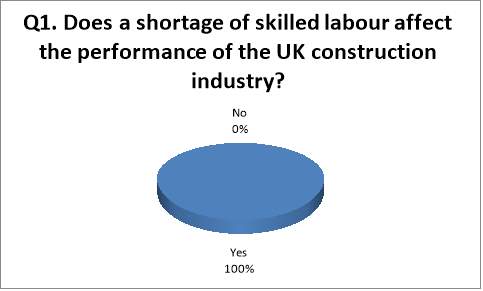
Results Analysis 1 – This pictorial chart represents the views of the respondents’ answers to a question that was aimed at finding out whether they believed the performance of the UK Construction industry was affected by a shortage of skilled labour. Interestingly, 100% of participants believed that a skilled labour shortage affected the performance of the UK construction industry. This strongly indicates that construction professionals acknowledge the importance of having an abundance of skilled labourers available in the UK, in order for the construction industry to perform at its best. Research conducted by the Royal Institute of Chartered Surveyors revealed that the existing skills shortage could hinder the progression of 27,000 projects, and the ability of construction firms to take on new projects up until 2019 (RICS, 2017). This data verifies the strong opinions held within the industry, and is already able to predict how a skills shortage will impact industry performance as a whole.
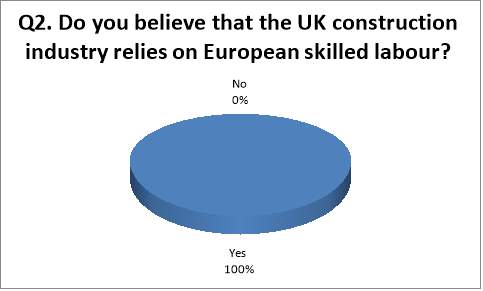
Results Analysis 2: This pictorial chart represents the view of participants’ answers to a question that was aimed at finding out whether the UK construction industry relies on EU skilled labour. An overwhelming 100% of respondents’ agreed that the UK construction industry is reliant upon EU skilled labour. This undoubtedly demonstrates that construction professionals believe that the UK has a strong reliance on EU skilled labour. The strong reliance can be attributed to employers preferring workers from the EU due to their skills, availability and willingness to do extra work (Meardi, 2017). The prominence of EU skilled labour is shown in statistics that reveal 1 in 6 construction employers have a high dependence on EU skilled labour that rises to 50% in London (Meardi, 2017). These compelling statistics reinforce the importance of the EU and UK relationship in terms of construction and the dependence of the UK on European skilled labour.
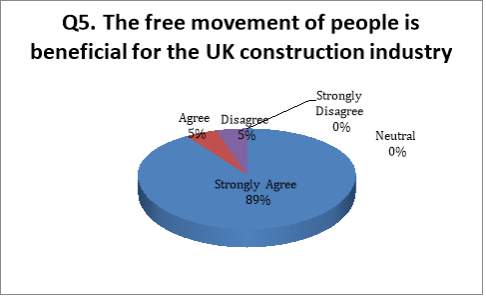
| 1 | 2 | 3 | 4 | 5 | Mean | |
| Q5 | 18 | 1 | 0 | 1 | 0 | 1.2 |
Results Analysis 3: This pictorial chart represents the views of participants’ regarding a statement that was aimed at finding out whether they believe free movement of people is beneficial for the construction industry. The mean value of the data is 1.2, which displays a strong viewpoint among construction professionals that free movement is indeed beneficial for the construction industry. It shows the importance free movement has within the industry and how dependent they are on it. According to Guglielmo Meardi (2017), the construction industry is heavily reliant upon the freedom of movement, and that without it, there will be an increased pressure on the industry in terms of the existing skills shortage (Thomas, 2016). This evidence as well as the analysis provided shows the importance of free movement for the UK construction industry.
Questionnaire – Objective 3
This section intends to focus on seven key statements pertinent to Brexit and its possible effects regarding the UK construction industry. Respondents’ were asked to rate these statements using a five-point Likert item to determine their level of agreement. Headline statistics reveal that a large number of respondents believe that the free movement of people is beneficial for the UK construction industry (85% strongly agreed with this statement); the UK construction industry would be less attractive than other EU construction industries for EU labour (78% either strongly agreed or agreed); access to skilled labour will be reduced (85% strongly agreed or agreed); and the growth of the UK construction industry will decrease (89% strongly agreed or agreed). Although these acuities are unlikely to become reality, the general perceptions felt within the construction sector is likely to reduce morale within it.
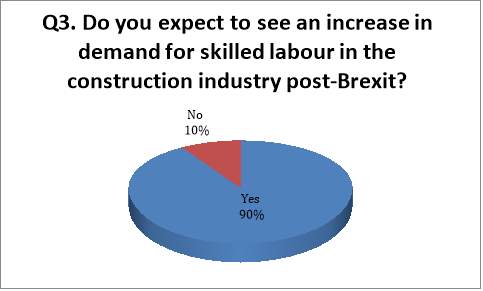 Effects of Brexit on the UK Construction Industry
Effects of Brexit on the UK Construction Industry
Results Analysis 4: This pictorial chart signifies the views of the participants’ answers to a question that was aimed at finding out whether the construction industry can expect to see an increase in demand for skilled labour post-Brexit. 90% of respondents’ said that they could expect to see an increase in demand for skilled labour within the industry post-Brexit. This data shows that construction professionals with experience in the industry recognise that there are currently a number of EU labourers working within the industry, and that Brexit may lead to a decrease in these numbers, therefore causing an increase in demand.
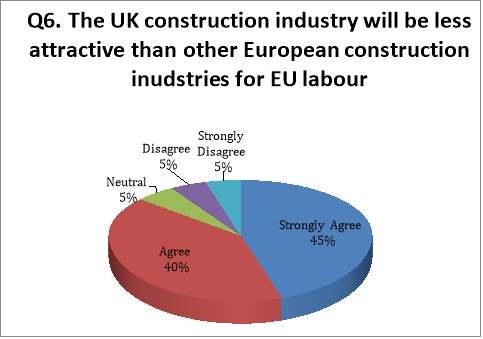
| 1 | 2 | 3 | 4 | 5 | Mean | |
| Q6 | 9 | 8 | 1 | 1 | 1 | 1.85 |
Results Analysis 5: This pictorial chart represents the views of participants’ responses regarding the statement on whether the UK construction industry will be less attractive than other European construction industries for EU labour. The results show that the majority of respondents (45%) strongly agree with this statement, with a further 40% agreeing. Only 5% disagreed and a further 5% did not have an opinion on this statement. Overall, the level of agreement is 1.85, which strongly agrees with this statement. These results show the general concern within the industry about how Brexit has the potential to leave the UK construction market unappealing to EU labourers, and will lead them to looking for work in the rest of Europe. The current rise in construction projects around all of Europe means that the UK is no longer the first choice for construction workers (Telegraph, 2018). This corroborates with the analysis of the statement and expresses the general view within the industry.
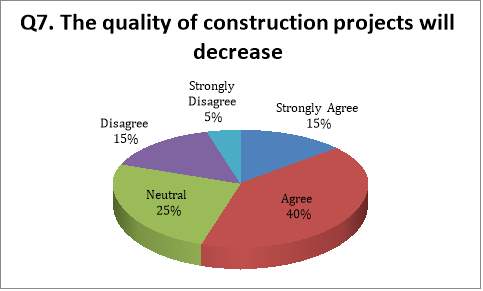
| 1 | 2 | 3 | 4 | 5 | Mean | |
| Q7 | 3 | 8 | 5 | 3 | 1 | 2.55 |
Results Analysis 6: This pictorial chart represents the opinions of participants’ regarding the quality of construction projects post-Brexit. The majority of respondents’ agree that the quality of construction projects post-Brexit will decline (40%), with a further 15% strongly agreeing. 25% of respondents did not believe that Brexit will affect the quality of construction projects, and overall 20% of respondents disagreed and strongly disagreed with this. The mean result of this statement is 2.55, which falls into the agree category. With over half of the respondents’ agreeing that the quality of construction projects will decline post-Brexit, this represents the general pessimism and doubt that is currently being felt within the industry. External research conducted found that the effects of Brexit would negatively affect the quality of projects, which is already on a decline due to the existing shortage of skilled workers (Scapegroup, 2016). The mixed results do however indicate that not all construction professionals believe that Brexit will affect construction projects directly, which leaves some optimism within the industry.
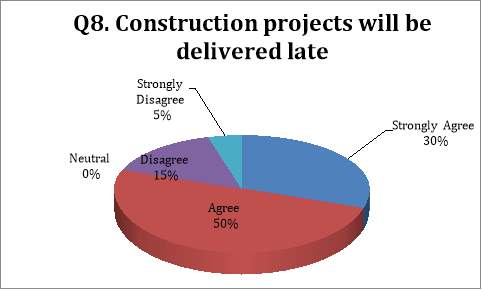
| 1 | 2 | 3 | 4 | 5 | Mean | |
| Q8 | 6 | 10 | 0 | 3 | 1 | 2.15 |
Results Analysis 7: This pictorial chart represents the opinions of participants’ responses based on the statement ‘construction projects will be delivered late.’ The results display high pessimism within the industry, as the mean value is 2.15 showing that the majority of participants agree with this statement. Exiting the European Union will lead to heavy duties being imposed on imports, which will lead to delays when importing and exporting necessary materials (Onions, 2017). These delays will inevitably cause delays in projects and an overall weakening in starts and outputs by -4% (Wilson, 2016). Only 10% of participants disagreed, which reinforces the doubt that looms over the industry due to the uncertain future that may potentially bring the UK’s construction sector to a standstill (Train, 2017).
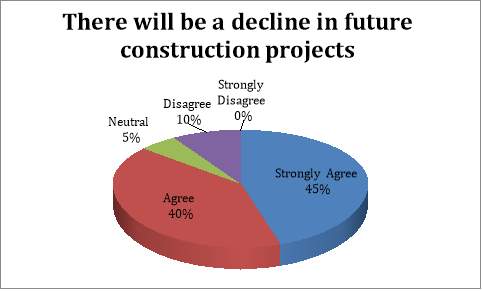
| 1 | 2 | 3 | 4 | 5 | Mean | |
| Q10 | 9 | 8 | 1 | 2 | 0 | 1.8 |
Results Analysis 8: This pictorial chart denotes the views of participants’ responses regarding the claim that ‘there will be a decline in future construction projects’ post-Brexit. These results show that the majority of respondents’ (85%) agree with this. The data has shown that there is a high concern regarding the ability to source a big enough workforce in order to take on projects. The mean score of these results is 1.8, which indicates the strong level of agreement within construction professionals regarding this statement. A recent survey carried out has revealed that the construction industry has sustained the sharpest drop in engineering works since April 2013 (CIPS, 2017). This is statistically represented by a fall in the Construction Purchasing Managers’ Index from 51.1 to 48.1, signalling a rapid decline in overall projects (CIPS, 2017). This data verifies the results of the analysis and the participants’ beliefs, validating the doubt within the industry.
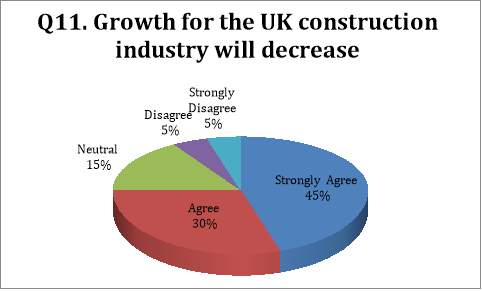
| 1 | 2 | 3 | 4 | 5 | Mean | |
| Q11 | 9 | 6 | 3 | 1 | 1 | 1.95 |
Results Analysis 9: This pictorial chart denotes the responses regarding a statement that was aimed at finding out the views of construction professionals on whether growth for the UK construction industry will decrease post-Brexit. The vast majority of respondents’ agreed with this statement (75%), with 45% of that proportion strongly agreeing. These results show that construction professionals recognise the value of having free labour movement between the UK and Europe, and that any restrictions on this will impede the rate of growth in the construction industry. This analysis can be corroborated with data that elucidates the effects the uncertainty of Brexit has triggered in terms of growth of the industry. The ambiguity of future relations with Europe has lead to a significant consecutive decline in the growth forecast for the construction industry by 0.9% in 2017, which follows a decline of 0.2% in 2016 (CIC, 2017).
Questionnaire – Objective 4
This category looks at two questions that seek to understand respondents’ views in relation to the impact of Brexit on the free movement of the construction labour to the UK. The results of the analysis of questions 4 and 9 indicates that the general feeling in the industry is one of scepticism and that Brexit will not have a positive impact on the free movement of the construction labour to the UK.
Investigating the Impact of Brexit on the free movement of the construction labour to the UK
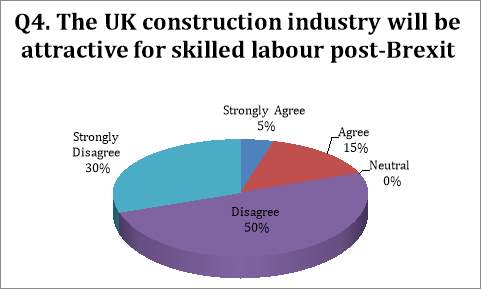
| 1 | 2 | 3 | 4 | 5 | Mean | |
| Q4 | 1 | 3 | 0 | 10 | 6 | 3.85 |
Results Analysis 10: This pictorial chart represents the participants’ views in regards to a statement that asks whether they believe the UK construction industry will be attractive for skilled labour post-Brexit or not. The results show an overwhelming majority (70%) disagree with this statement and think the UK construction industry will become an unattractive option for skilled labourers and will impact the numbers coming from Europe (Wallace, 2017). In the wake of Brexit, there has been a rise of emigration of EU citizens from the UK. This can be attributed to them feeling unwelcome, and the apprehensions concerning the performance of the UK economy as a result of Brexit and the GBP falling (Busse and Barslund 2017). Only 15% of respondents’ felt that the UK construction industry would be attractive for skilled labour post-Brexit and this emphasises the lack of morale and confidence amongst the industry on the future and outlook of the industry post-Brexit. This difference in opinion is represented by the mean value of 3.85 and shows the stronger opinions towards Britain becoming an unattractive option for skilled workers.
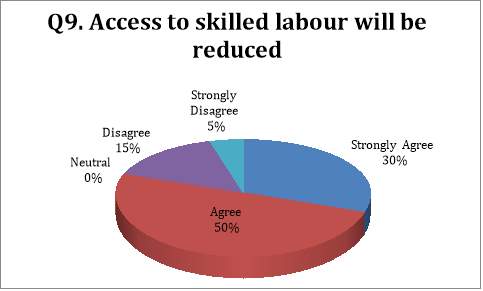
| 1 | 2 | 3 | 4 | 5 | Mean | |
| Q9 | 6 | 10 | 0 | 3 | 1 | 2.15 |
Results Analysis 11: This pictorial chart represents participants’ views in relation to a statement aimed at finding out whether they believe access to skilled labour will be reduced post-Brexit or not. These results again show that 80% of participants’ believe that there will be a reduced access to skilled labour post-Brexit. The remaining 20% disagree that this Brexit will reduce access to skilled labour, however this could be down to a number of reasons including a lack of awareness of what Brexit will entail in terms of free movement and labour access. The level of agreement of participants falls at 2.15, which shows a strong majority agree that there will be a reduced access to skilled labour. With Brexit negotiations on going, Theresa May has stated that access to the single market and labourers will be ‘less than it is now’ (Hunt and Wheeler, 2018). This nature of Britain’s exit from the EU is likely to end in a reduction of access to skilled labour from Europe (Swales and Baker, 2016). This will lead to broad implications for the construction sector such as increased project (Sutherland, 2016) and import costs (Scape Group, 2017).
Summary
This chapter has successfully analysed and justified the findings from the results of the questionnaire. It has looked into the most significant questions surrounding the subject of Brexit and its potential effect on the UK construction industry, and gained the viewpoints of professionals currently in the industry.
Chapter 5 – Analysis and Discussion
Introduction
The aim of this chapter is to recap on the initial purpose of this paper and evaluate the objectives of this research in order to gain a clear understanding of the implications Brexit may have on the UK construction industry. A detailed conclusion with recommendations based on the findings of the research conducted will be provided for a more in-depth exploration of the subject at hand. The final section will comprise of any limitations of the study that may have affected the research.
Summary and Conclusion of Research Objectives
This study was conducted in order to analyse the current reliance the UK construction industry has on the European Union’s skilled labour force, and to explore the possible effects Brexit could have on the industry. The author used the Literature Review (chapter 2) and the questionnaire data analysis in order to satisfy the research objectives.
Objectives 1 and 2
The main focus of objectives 1 and 2 was to evaluate the current situation of skilled and unskilled labourers in the UK construction industry, and analyse the present the UK construction industry has on foreign skilled and unskilled workers from countries in the European Union. According to the Office for National Statistics, 33% of construction workers come from the EU (ONS, 2016), with the industry heavily relying upon their skilled workers in order to execute infrastructure projects (Rolfe and Hudson-Sharpe, 2016). The results of the analysis performed supports these statistics and indicates that all of the participants agree that the UK construction industry is reliant upon skilled labour, and are acquainted with the importance they have in maintaining the growth of the industry. This is most likely attributed to the foreign workers’ flexibility and willingness to learn and develop their skills, and being able to successfully work on jobs (CIPD, 2018). Both the literature review and data analysis emphasize the importance of skilled labour for the construction sector.
Objective 3
The primary focus of objective 3 was to understand Brexit and its possible effects with a particular focus on the UK construction industry. The literature review established that the UK construction industry is already undergoing a skills crisis, and that Brexit will only serve to exacerbate this issue. Data showed that in light of Brexit, the industry could face losing 200,000 EU workers if the country fails to retain access to the single market (RICS, 2017). Consequently, this will impact negatively on the performance of the industry as a whole (Meardi, 2017). Several of these implications can be noted including reduced access to skilled labour (Swales and Baker, 2016); the construction sector lacking appeal to EU workers (Wallace, 2017); a decline in productivity (CIPS, 2017) and project quality (Scapegroup, 2016); and a decline in the growth of the industry (CIC, 2017). In Chapter 4, the results of analysis’ 3, 6, 7, 8, 10 and 11 corroborates with the research conducted and indicates that the majority of participants agree that Brexit will result in these implications.
Objective 4
The final objective was intended to evaluate the impact of Brexit on the free movement of the construction labour to the UK. In a recent speech made by Theresa May, it was made clear that access to the single market would be significantly reduced. This hard nature of the Brexit deal will trigger a decline in access to skilled labour from Europe (Swales and Baker, 2016). The data collated and analysed in Chapter 4 confirms that industry resistance against Brexit is prevalent and that many believe Brexit will reduce the supply of skilled labour rather than enhance it. The results of the analysis’ of objective 4 has revealed the industry’s negative connotations associated with Brexit that could deter skilled workers from Europe entering the UK construction sector. This is a by-product of the drop in value of the Great British Pound, leaving people feeling apprehensive about the economy (Busse and Barslund, 2017).
Limitations and Recommendations
Limitations
The aim of this paper was to explore the effects Brexit will have on the UK construction sector by completing the objectives in Chapter 1. The research was carried out using a desk study and collecting fieldwork data with a quantitative research approach. There were various limitations to the study that should be noted. Despite there being several resources available in regards to the data collected in the desk study, which is what the author predominantly relied upon, there are limitations to the data obtained and used. This includes the potential of it being biased, obsolete, and misrepresentative causing irregularity and inaccuracy in the study and results given. The data given regarding the numbers of the foreign workforce should be treated as an approximation rather than precise figures due to the nature of migration and construction as an industry. It is therefore impossible to establish these figures with 100% accuracy and should therefore be taken into consideration. Additionally, obtaining ‘primary data’ to gain a broader view of opinions from construction professionals proved difficult due to time and cost. Despite the author being able to design and distribute a questionnaire, many limitations were faced such as having a lack of contacts within the industry. Finally, the time constraint on the project further limited the amount of areas that could have been considered for research and data that could have been collected in total.
Recommendations
In order to overcome the potential detrimental impact that Brexit may potentially have by further worsening a pervasive skills shortage, it is recommended that the free movement of people and workers be retained. This can be accomplished if the UK joins the European Free Trade Association and remains a part of the European Economic Area, guaranteeing the free movement of goods, people, and services whilst pacifying the notion of stronger national sovereignty. Skilled labourers that currently live and work in the UK for the construction sector should be encouraged to remain through the application of incentives such as an increase in wages, more overtime, reward schemes, and a reduction in physical work which could be made possible by introducing more technology within the sector. There should also be efforts to attract future generations to work in construction by making it more appealing to youngsters and portraying it in a way that will entice any gender or age group to work. This can be achieved by marketing advanced technology more effectually to the younger audience.
Whilst deciphering the initial aims of the paper, further directions for future work to be done have become apparent; mainly developing practical policies to resolve the skills shortage that Brexit will deepen and developing innovative ways to attract skilled labourers to build a long-term career in the sector.
Cite This Work
To export a reference to this article please select a referencing stye below:
Related Services
View allRelated Content
All TagsContent relating to: "Brexit"
Brexit refers to the withdrawal of the UK from the EU on 31st January 2020 following a UK wide vote in 2016 in a referendum held by David Cameron’s pro-Europe government. 51.9% of voters voted in favour of leaving.
Related Articles
DMCA / Removal Request
If you are the original writer of this dissertation and no longer wish to have your work published on the UKDiss.com website then please:




